The CSS Solved General Science & Ability (GSA) Past Paper 2018 is Solved by Pakistan’s top GSA Coaches, Miss Iqra Ali and Sir Ammar Hashmi. They are the only coaches available in Pakistan who have solved the last 20 years GSA solved papers to help aspirants know how to attempt the paper to score above 80. And they have guided thousands of CSS and PMS aspirants. Both coaches have been known for their teaching methodology and imparting concepts to their students, who scored the highest marks in this subject. At the special request of CSSPrepForum, both coaches have solved the paper.

Question – 02
A. Describe different methods to estimate the age of the Universe.
Question Breakdown:
In this question, the examiner has simply asked you to explain the methods to measure the age of the universe. Hence, all you have to do is to start your question with the general explanation of the universe in two or three lines and directly move toward the methods with a little description of each method. Remember, some questions are so simple that no creativity also becomes creativity. Using formulas where required can help you obtain good marks.
Answer:
Universe
The totality of everything that exists or has existed both in space and time, including all matter and energy, planets, stars, and galaxies, is known as the Universe.
Methods to measure the age of the universe
There are two methods scientists rely on for calculating the age of the universe which are the following
1- Calculating the expansion rate of the universe:
According to scientists, the universe is approximately 14 billion years old. It is the age of the universe that is estimated from the big bang. According to this method, we assume that the universe is expanding at a constant rate by using Hubble’s constant (Ho).
Hubble noted that the distance of a galaxy is directly proportional to its speed, and means. The further the galaxy was, it was moving away.
d=vt
t=d/v
where, v= Hod
t=d/ Hod
t=1/H
Hence, scientists were able to use the Hubble constant to estimate the age of the universe by working backwards to Big Bang.
2- By determining the age of the oldest universe:
Scientists determine the age of the universe from the following
✔ Spectrum:
The star’s spectrum helps determine the age of stars because blue stars tend to die faster than red stars.
✔ Luminosity:
A brighter star will exhaust its energy faster than a less bright star. Therefore, the star with less luminous intensity exists for a longer time than with a more luminous intensity
✔ Mass:
The amount of a star’s mass also helps in finding the life of a star. If a star is dense, it tends to die quickly as compared to a less dense star. Thus, the density factor also helps calculate a star’s life.
✔ Motion/Speed:
The brighter star tends to have more energy; in turn, its speed will be greater than the comparatively less luminous star. Eventually, the brighter star will consume its energy quickly and die before the other less bright star, thus, will have a short life and vice versa.
B. Explain the formation of the Lunar Eclipse.
Question Breakdown:
In this question, the examiner has asked you about the phenomenon of the formation of the lunar eclipse. Thus, start your answer by defining Eclipse in your own words and then move toward the formation of the lunar eclipse. Writing the types of the eclipse to clarify the formation of each type is a good approach for attempting this question. In the end, draw a schematic diagram explaining the whole phenomenon in one image.
Answer:
Eclipse:
The eclipse means the obscuring of one astronomical object by another.
Lunar eclipse formation:
Lunar eclipse means obscuring the moon from the Sun’s light by the Earth’s interaction between the Sun and the moon. In other words, when Earth comes between the Sun and the moon and casts the shadow across the lunar surface. This situation is called a lunar eclipse. It’s a common phenomenon, and about three lunar eclipses occur yearly.
Types of lunar eclipse:
1- Complete lunar eclipse
When the entire moon comes under the Umbra part of the shadow, it is called a complete lunar eclipse. It happens when it is a full moon, and the Sun, Earth, and Moon are aligned in a straight line.
2- Partial lunar eclipse
When the moon passes through the part of the Earth’s Umbra region, it is called a partial lunar eclipse. It occurs due to the imperfect alignment of the Sun, Earth, and moon.
3- Penumbral lunar eclipse
When the moon travels through the Earth’s penumbra, it is called a penumbral lunar eclipse. It also occurs due to the imperfect alignment of the Sun, Earth, and moon.

B. Explain the terms Dark Energy and Dark Matter.
Question Breakdown:
In this question, the examiner has simply asked you to explain the terms Dark energy and dark matter in your own words based on your understanding. Start your answer by explaining dark energy with appropriate examples and then move to the dark matter; write that too with the appropriate example. When done, draw diagrams depicting dark energy and dark matter of the universe. Remember, writing too much can never help you get maximum marks; however, what helps you get good marks is your presentation.
Answer:
Dark Matter:
Dark matter comprises particles that do not reflect, absorb, or emit light. Thus, they cannot be detected by observing electromagnetic radiations. It is a material that cannot be seen directly. It is a mysterious and invisible substance. We believe it exists because of its effects on the objects.
Moreover, the force of dark matter is always attractive. It attracts all the particles even though light cannot move out of them. Astronomers believe that dark matter exists because visible matter does not have enough gravitational muster to hold galaxies together. The composition of dark matter is: super-dense astronomical bodies called massive astrophysical compact halo objects (MACHOs) and weakly interacting massive particles (WIMPs).
For example:
Neutron stars
Black holes
Dark energy:
Dark energy is the energy that helps in the expansion of the universe. In fact, in 1998, astronomers studying distant supernovae were shocked to learn that the universe began expanding faster around 7.5 billion years after the Big Bang. That indicates some unknown force is fighting gravity’s pull, causing galaxies to speed apart from one another. Dark energy is a repulsive force. It is the opposite of dark matter. Dark energy repels the objects, due to which things move far away from each other.
For example:
Phantom dark energy, where not only is expansion accelerating, but the acceleration is also increasing over time-the Big Rip, where expansion becomes infinitely fast, tearing galaxies, atoms and the fabric of space-time itself apart.
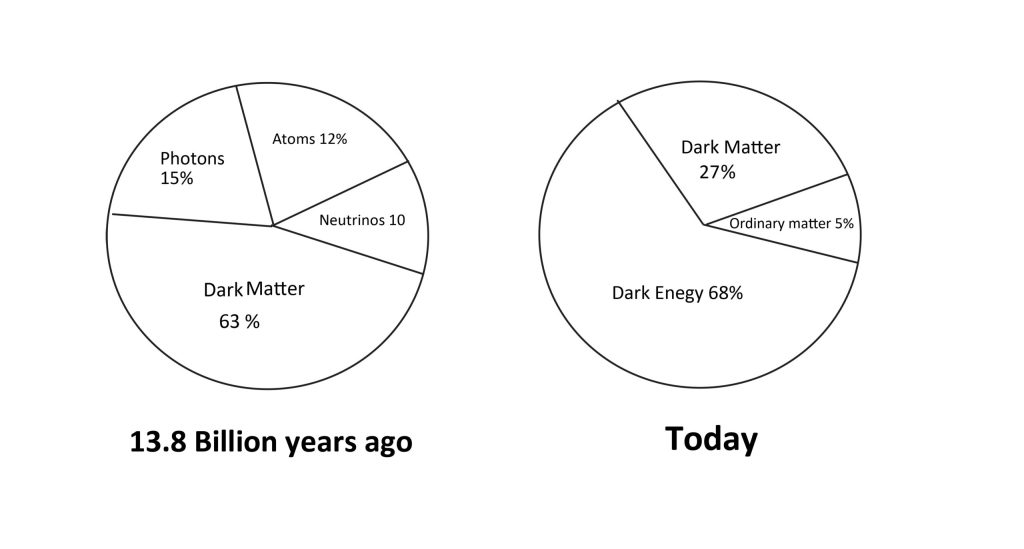
C. Define the term Black Hole. What’s expected inside it?
Question Breakdown:
The examiner has simply asked you to explain the Blackhole with the content inside it. Thus, first write the understanding of the term black hole, its example, and the process of its formation in detail. When done, move to the next part of the question explaining the expected components of the black hole in three to four lines. Although no diagram is required in the question, making a key for the formation of the black hole can make your presentation noteworthy.
Answer
Black Hole:
A black hole is a cosmic body in the centre of almost every galaxy in the universe, including the Milky Way galaxy in which our solar system exists.
Examples:
Sagittarius A* is a supermassive black hole that exists at the centre of the Milky Way Galaxy.
Formation of Black Hole:
A black hole is formed by the death of extremely massive stars with more than three solar masses. At the end of a massive star’s life, the core of the star becomes highly unstable and is collapsed. The crushing weight of constituent matter falling in from all sides compresses the dying star to a point of zero volume and infinite density called the singularity
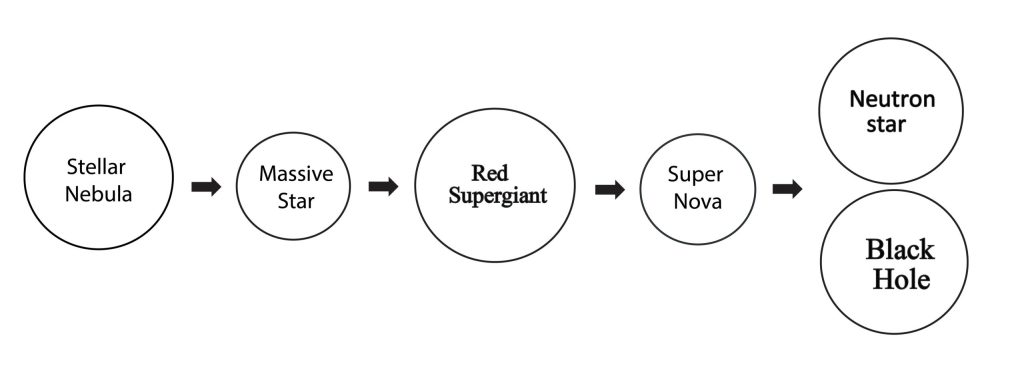
What is expected inside the black hole?
The black hole is called a black hole because the gravity and density inside the black hole are so strong that it attracts everything coming toward it, even the electromagnetic radiation cannot escape. Hence, the black hole cannot be observed directly. However, it can be observed by its gravitational influence on nearby matter. The boundary of black holes is called the event horizon.

Question – 03
A. Describe different causes and preventions of ‘Polio’
Question Breakdown:
The examiner, in this question, has simply asked you to describe the causes and prevention of polio. Thus, start your question by defining the jargon- Polio- in one or two lines with a key mechanism. When one, moves to the causes of polio and write them in bullet form. In the end, write the preventive measures also in the bullets or points because we do not need to write too much about both since the question is already split up into two parts. Remember, being creative is what will award you maximum marks on your GSA paper. Lastly, you do not need to draw any diagram for this question.
Answer:
Polio:
Polio is the inflammation of the grey matter in the spinal cord. It is an infectious viral disease. It can cause paralyze in the severe condition.
Mechanism:
A virus called poliovirus causes polio.
Virus→mouth/nose→digestive/respiratory systems (multiplication)→bloodstream→nervous system→Whole body
Causes:
✔ Person-to-person contact
✔ Oral route(Infected Phlegm from the nose or mouth )
✔ The faecal route, any contact with the infected faeces of the individual
✔ Excessive use of intramuscular injections.
✔ No proper past vaccination in childhood.
Preventions:
✔ There’s no cure for polio, but the vaccines like inactivated poliovirus vaccine (IPV) and Oral poliovirus vaccine (OPV) allow your body to fight off the virus.
✔ The other prevention for polio includes ensuring hygiene and encouraging good sanitation practices
✔ Further, contact with the infected person should be avoided.
B. Define the term ‘Bio-Fuel’. How is it helpful to promote clean energy??
Question Breakdown:
This question has basically two parts. While answering the question, you need to define bio-fuels in your own words with an appropriate example. When done, jump to the next part in which you are supposed to explain the advantages of bio-fuels in the context of green energy. Comparing the wastes of a bio-fuels production unit with a conventional fuel production unit in a diagram can better explain your stance. Remember, writing too much can never help you get maximum marks; presentation is what helps your papers stand out among thousands.
Answer:
Definition:
Biofuel is considered to be the purest and the easiest available fuel on the planet. It is also known as agro-fuel. They may be in solid, liquid, and gaseous forms derived from biomass.
For example:
Biodiesel is an alternative fuel for diesel engines that is produced by chemically reacting a vegetable oil or animal fat with an alcohol, such as methanol and ethanol.
Bio-fuel and clean energy:
Biofuels are very helpful in the production of pollution-free energy. It is because, ethanol-a biofuel- can produce 48 % less carbon dioxide content than conventional gasoline. Carbon dioxide is the major contributor to pollution. Hence, biofuels are very helpful in reducing air pollution. Moreover, the production of biofuels is environmentally friendly. Therefore, it does not play a role in global warming. The reason is that it does not produce greenhouse gases: carbon dioxide, nitrogen- chlorofluorocarbon, methane etc. in addition to it, the agricultural waste can easily be managed, which is responsible for the production of methane gas. Thus, biofuels play a crucial role in pollution-free energy.
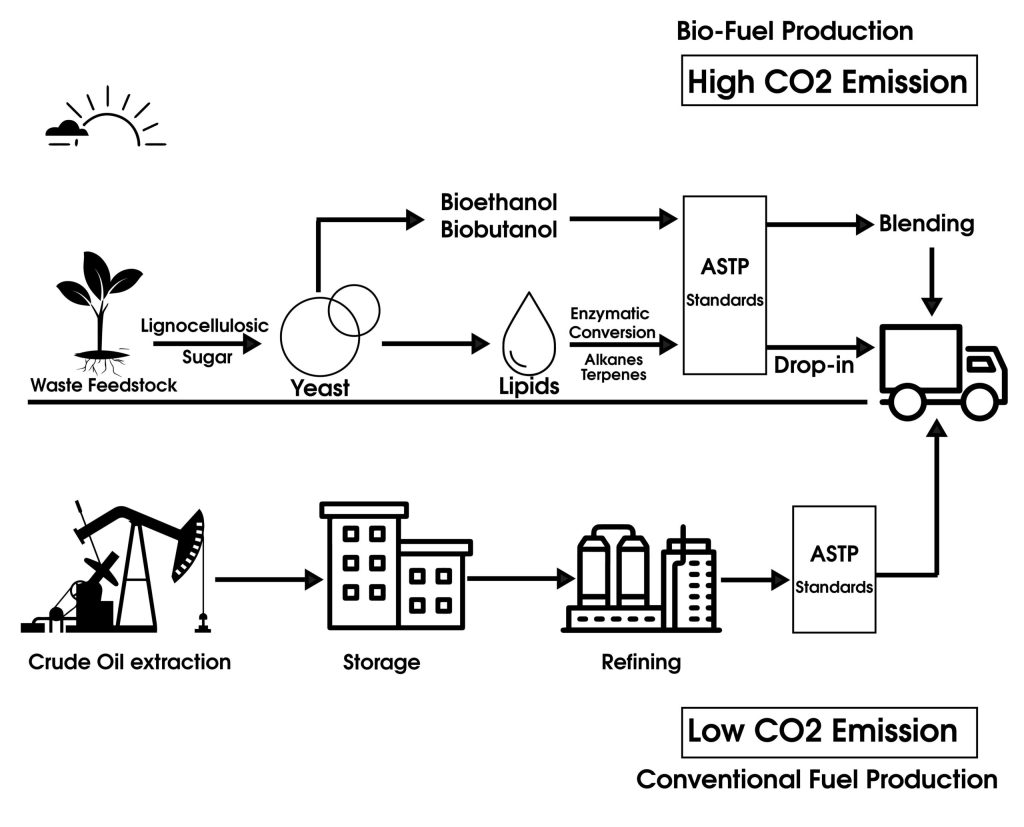
C. Define ‘Carbohydrates’. Describe different steps to digest these in the human body.
Question Breakdown:
The question again has two parts. The first part is dealing with the general description of carbohydrates; thus, write about carbohydrates and what you know: define example, formation, general formula, etc., briefly. While the second part wants you to write the steps of the general mechanism of carbohydrates digestion, write in bullet/steps with an appropriate diagram. Last but not least, be to the point and specific. Overwriting does nothing but devalue the quality of your paper.
Answer:
Carbohydrates:
Carbohydrate is derived from the two words: carbo means carbon, and hydrate means hydrogen. Hence, carbohydrates contain water and hydrogen. They are also called ‘sugars’. They are the most abundant molecules on the surface of the earth.
Their empirical formula is Cx (H2O)y
Formation:
Moreover, they are prepared by the photosynthesis process in plants.

Carbon dioxide+water+sunlight -> Glucose+Oxygen
The process is taken place in the presence of sunlight and chlorophyll. Glucose is obtained as a byproduct. It is further polymerized to form starch and cellulose.
Steps to digest the carbohydrates in the human body:
Carbohydrates start to digest as they enter the mouth.
✔ Mouth
In the first step, in the oral cavity, the salivary glands are present that produce saliva. It provides moisturization to food particles. Saliva releases an enzyme amylase that acts on the carbohydrates-sugars- and starts to break them down.
✔ Stomach:
In the second step, the food particles enter the stomach, and stomach walls produce enzymes and dilute HCL to kill bacteria in the food.
✔ Small gut:
In the third, these particles enter the duodenum of the small intestine. It activates the pancreas for the secretion of pancreatic amylase that breakdown the chime into maltose. From here, lactase, maltase, and sucrose form on the walls of the small intestine. These enzymes further break down the sugars into monosaccharides or most uncomplicated sugars. The insulin hormone released from the pancreas that breakdown the larger sugar molecules into glucose and allow it to use as energy for the body.
✔ Colon:
In the fourth step, the breakdown material passes to the colon. Here, further digestion is taken place by the secretion of intestinal bacteria. Fibres are present in carbohydrates that are not soluble. Hence, they release from the body through the bladder.

D. Describe the ‘Cell Structure. Write down at least three differences between an animal cell and a plant cell.
Question Breakdown:
In the first part of this question, the examiner has asked you to describe cell structure. While attempting this question take both parts as holding 2.5 marks each and write accordingly. Do not dig too much into the cell structure and just discuss the three main components of the cell covering everything within it. Then move to the second part of the question, in which the examiner has asked to write only three differences in plant and animal cells. Writing the differences in the tabular form is the best possible option. Lastly, draw the basic diagram of both animal and plant cells.
Answer:
Cell:
The cell is the basic structural and functional unit of life. Millions of cells are present in the human body. The size of cells is very, thus, cannot be seen through the naked eye. Instead, microscopes are used to see them. Robert Hook discovered the partition in 1665.
Cell structure:
1. Cell Membrane:
The outermost layer of the animal cell and the second most outer layer of the plant cells is called the cell membrane. The major components of the cell membrane are carbohydrates, phospholipids, proteins, and other lipids such as cholesterol. Together these components make up the fluid mosaic model. In plant cells, different cell wall is present outside the cell membrane.
2. Cytoplasm:
In addition to it, cells have cytoplasm. It is fluid-like material that is present between the cell membrane and Nucleus. All the cell organelles: Endoplasmic Reticulum-detoxifying the harmful bacteria that enter through food along with the preparation of protein, Ribosomes-helping in the digestion of food, Golgi bodies-preparing the protein into the final product and sending it to where it is needed, Mitochondria-providing energy to the body, plastids-assisting in the photosynthesis process, Vacuoles-acting as storehouses of water and other metabolic products, etc., are located within the cytoplasm, each having its distinct composition for the particular function.
3. Nucleus:
The other major component of the cells is Nucleus, being in the centre of animal cells and at the side of the plant cells. The Nucleus of the cell consists of the nuclear membrane, nucleolus, nucleoplasm, and chromosome that carries the genetic information in DNA, a part of the Nucleus.
| Features | Plant cells | Animal cells |
| Nucleus | The nucleus is present near the cell membrane | The nucleus is in the centre of the cell |
| Vacuole | They have a relatively large vacuole | They have a relatively small vacuole |
| Cell Wall | They have a cell wall | They do not have cell walls |
| Centrioles | They do not have centrioles | They have centrioles |
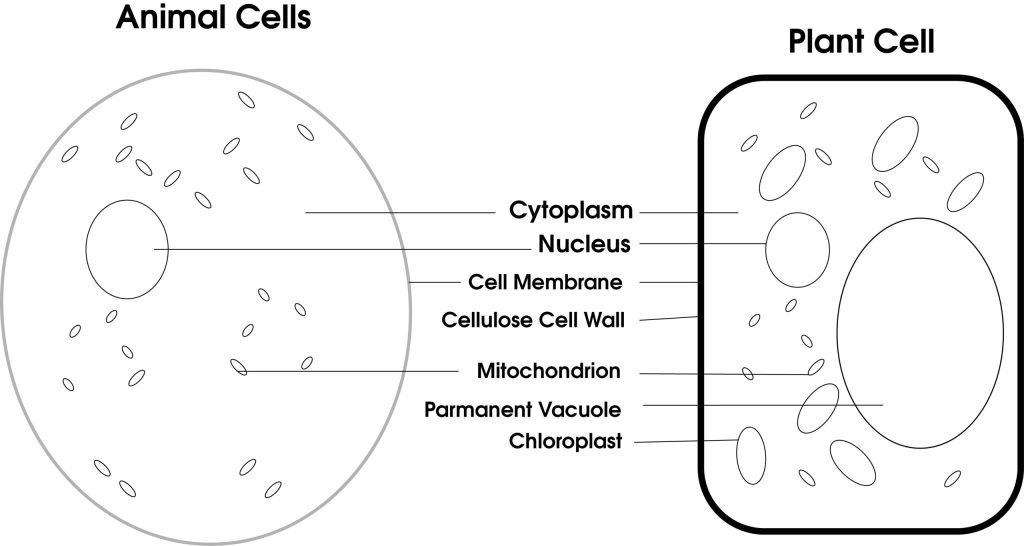
Question – 04
A. What is ‘Acid Rain’ Describe its causes and how it can be prevented?
Question Breakdown:
In this question, the examiner has simply asked you to explain acid rain. Therefore, you need to answer the question with a proper definition of acid rain, the causes behind acid rain, and the preventive measures to control acid rain. Being creative is what will award you maximum marks in your GSA paper. Lastly, you do not need to draw any diagram for this question.
Answer:
Acid Rain:
When the PH of the rainwater is less than 5.6, such rainwater is called acid rain. The PH decreases because when the rainwater passes through the atmosphere it reacts with the oxides of nitrates and sulphate. It forms sulfuric and nitric acid, as a result.
Causes:
The causes of acid rain are given below.
1. Sulphur dioxide is released from natural disasters, especially from volcanic eruptions, industries, and transportation.
2. Oxides of nitrogen are released from transportation, fertilizers, and pesticides.
3. Oil refineries and power plants of fossil fuels also cause the emission of oxides of sulfur and nitrogen.
Reactions:

Preventions:
✔ The mode of transportation should be replaced. Use public transport instead of private transport. It is preferable to walk.
✔ The use of energy-efficient appliances, such as air conditioners must be reduced.
✔ Non-renewable energy should be replaced by renewable energy resources.
✔ The use of fossil fuels must be limited.
✔ Devices like scrubbers must be used to chemically remove SO2 from the gases leaving the smoke stack to use as a raw material.
B. What is ‘Water Pollution’ Discuss its causes and measurement methods. Name the countries with the highest and lowest percentage of it.
Question Breakdown:
In the first part of the question, the examiner has asked you to write about water pollution, its causes, and various methods to measure water pollution. Moreover, in the second question, the examiner has simply asked you to list out the countries’ names having the highest and lowest percentage of water pollution. Keep in mind not to write too much in your GSA paper since the question contains no more than five marks. The more the parts of the question become, the less get their weightage. Hence, your question must be concise and complete at the same time
Answer:
Water Pollution
Any change in the physical and chemical properties of water that make it unsuitable to drink and for the use of other purposes.
Causes of Water Pollution:
1. Physical Pollutants:
Physical change in water occurs due to harmful secretion of the products from industries, municipal etc.
2. Agricultural Pollutants:
The products used in the agricultural sectors like fertilizers and pesticides release many harmful chemicals. These chemicals are added to the water and used by humans.
3. Hospital Pollutants:
The waste released from the hospitals like syringes, bottles, wrappers etc. Such waste causes water pollution.
Measurement of Water Pollution:
Water pollution is particularly measured by
✔ Measuring physical factors oxygen, pH, temperature, salinity and nutrients (nitrogen and phosphorus) can help indicate the quality of water.
✔ Measuring toxicants such as insecticides, herbicides, and metals also help provide information on what is impacting the system.
✔ Biological indicators-measures of macro-invertebrate or fish diversity, benthic algal growth, and benthic oxygen demand- are direct measures of the health of the fauna and flora in the waterway.
Countries with Highest and Lowest Water Pollution:
✔ India is the country having the highest water pollution.
✔ Sweden is the country that has the lowest water pollution.
C. Write a comprehensive note on Smog?
Question Breakdown:
In the first part of the question, the examiner has asked you to comprehensively explain Smog. Thus, you can write the answer peer your ease. You can write what you know since the question is not specific. Start with defining, and then write composition, causes, effects, and prevention of smog in bullet forms to give it a complete yet comprehensive overview of smog. Keep in mind not to write too much in your GSA paper since the question contains no more than five marks; thus, write accordingly.
Answer:
Define:
Smog is the combination of smoke and fog. It is air pollution that reduces visibility.
Composition:
Fog is the cloud of droplets that are present near the surface of the earth. The visibility in fog reduces by 1 km. It is high in density and contains large numbers of droplets. But, these droplets are smaller in size. On the other side, smoke contains pollutants. These pollutants come from industries, fertilizers, pesticides, transport etc. The contaminants are NOx, SOx, CO, and CO2. But, the main components of smoke are particulate matter-dust particles- and ground-level ozone. Smog forms when the sunlight and its heat react with pollutants in the atmosphere. These pollutants come from many sources. It forms smog.
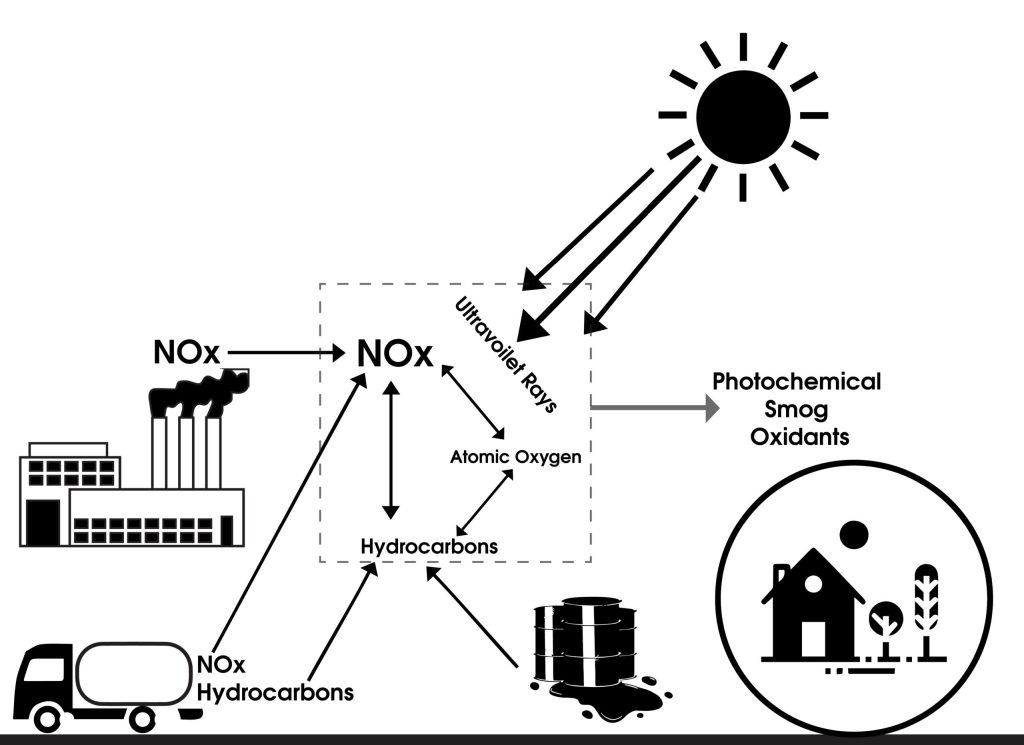
Causes of Smog:
✔ Overpopulation is a significant cause of smog. More usage of agricultural products, industries, and transport increases pollution.
✔ Fireworks also increase the level of air pollutants in the atmosphere. On Diwali, the big cities have a high level of smog.
✔ The use of coal as a fuel has become a prominent contributor to the smog.
Effects of Smog:
✔ The pollutants present in the smog enter the human body through inhalation. It causes bronchitis, lung cancer, and other respiratory disorder.
✔ The pollutants in the smog also cause skin cancer, skin rashes, and redness of the skin can occur.
✔ Road accidents increase because the visibility sometimes decreases by 1km.
Preventions of Smog:
Preventive measures should be taken to avoid the harmful effects of smog. First, wearing a mask is the best to prevent the inhalation of smog pollutants into the body. Moreover, staying at home is the best solution to prevent road accidents.
D. Describe different causes of ‘Tsunami’. Is there any difference between a Tsunami and a tidal wave? Name the worst Tsunami ever recorded.
Question Breakdown:
The question consists of three parts. In the first part, you are supposed to write the main causes of tsunamis comprehensively; thus be very specific while attempting the answer. Next, draw a table to differentiate tidal waves and tsunamis. And last, just write down the names of the worst ever recorded tsunami in no more than one line. Remember, stick to what the examiner has actually asked; do not stretch your question with unnecessary information if not required. No diagram is needed in this question
Answer:
Tsunami:
A series of waves that are produced due to the sudden disturbance under the water’s surface is called a tsunami. These waves are harbour waves. These are also called seismic sea waves.
Causes of Tsunami:
✔ Undersea Quakes:
Almost 80 per cent of Tsunamis are produced due to abrupt disturbances under the ocean sometimes by the earthquake. It is the process, in which the tectonic plates slide over the other plates beneath them. Due to it, these plates sink into the earth’s mantle. As a result, harbour waves produce and lead to tsunamis.
✔ Volcanoes:
Sometimes, tsunamis are caused by volcanic eruptions since the volcanic eruption, on the one hand, is responsible for raising the earth’s temperature and on the other hand for the movement of tectonic plates.
✔ Asteroids Crashing into Ocean:
It is a very rare case when these harbour waves produce due to the striking of meteorite with the oceanic surface.
✔ Undersea landslide:
When the land under the ocean slides the way it does above- at the earth’s surface- it causes irregular horrible changes in the movement of water leading to tsunamis.
It is observed that an earthquake on the Richter scale greater than 7.0 can cause a disastrous and horrible tsunami.
Difference between tsunami and tidal waves:
| Tsunami | Tidal waves |
| These waves produce only due to geographical events: earthquakes, volcanoes etc. | These waves produce only due to the gravitational pull of the moon and sun. |
| Tsunamis only occur under the oceanic surface | Tidal waves occur in rivers, lakes, and other water bodies. |
| The blow of air across the surface of the ocean does not cause a tsunami. | A blow of air can cause the production of tidal waves often called wind waves. |
The worst tsunami ever recorded:
The worst tsunami was recorded in Indian ocean-Sumatra, Indonesia in 2004. 300,000 people died in this disaster.

Question – 05
A. Write a note, on how data is stored on a ‘Hard Disk’?
Question Breakdown:
In this question, the examiner has simply asked you to explain how data is stored on a hard disk. Hence, all you have to do is to start your question with the general explanation of what is the hard disk in two or three lines and directly move toward how data stored on the hard disk while explaining its structure. Remember, some questions are so simple that no creativity also becomes creativity. Using diagrams can help you obtain good marks
Answer:
Hard Disk:
A hard disk is a device used to store data permanently. It is a magnetic storage medium. The data can be read and written on it. A hard disk is also called a hard drive, fixed drive, and hard disk drive. A hard disk can store data in trillions of bytes.
Data stores on hard disk:
A hard disk is a disk that can store data even when no electrical power is supplied to it. The magnetic property of a hard disk enables it to store data. In computers, binary language is used: 0 or 1. A hard disk consists of a circular disk called a platter. It is made up of Aluminium that is coated with nickel, cobalt, and platinum. It becomes a magnet. Over it, the coating of carbon is made to make the surface of the disk smooth to avoid the deterioration of the data.

The platter is divided into many small circular sectors. These areas are to specify where to store the data. Moreover, there is an arm like the read and write head, which remains on the platter but does not touch it. The distance between the platter and head is in nanometers. It is to prevent scratches on the platter. The sectors on the platter give information about their storage capacity. The more circular sectors the more capacity to store data. To read and write the data of the whole platter the upper and below heads are placed. Electromagnet generates a magnetic field and through the coil, the impulse of electric current is received. This magnetic property helps hard disks store data.
B. How an ‘Optical Fiber’ is constructed? How is it helpful in transmitting electromagnetic radiations?
Question Breakdown:
In the first part of the question, the examiner has asked you to explain optical fibres and their structure. So write step-wise by initiating with the definition of optical fibres. Then, write a very comprehensive structure of OC and move to the second part of the question, i.e., explaining its mechanism of working. Keep in mind not to write too much in your GSA paper since the question contains no more than five marks. The more the parts of the question become, the less get their weightage. Hence, your question must be concise and complete at the same time
Answer:
Define:
Fibre optics is a bundle of thin strands made of glass or plastic, which uses light (photon particles) to transmit signals. Therefore, the transmission capacity of fibre optic is far greater than other modes of communication, such as copper wire and metallic wires. As a result, it is used in the form of different cables and is being utilized in numerous fields of life.
The basic structure of Optical Fibers:
✔ Optical fibre consists of four layers
✔ Core made up of glass
✔ Cladding is a reflective layer made up of glass or plastic
✔ Coating cover as a protective layer
✔ Jacket to bundle all fibres in one cable.

Types of Optical Fiber:
There are many types of optical fibres. However, the most significant types are
1. Single-mode Optical Fiber:
A fibre that is designed to carry a single signal at a time
2. Multi-mode Optical Fiber:
A fibre that is designed to carry more than one signal at a time
Working of Optical Fiber:
The propagation of light in an optical fibre requires that light should be totally confined within the fibre and not escape from it. This can be done by
1. Total internal reflection
2. Continuous Refraction
In a fibre-optic system, a machine called a transmitter turns information into the light. Then the transmitter sends the light through optical fibres. As the light moves at a high speed through the core, it bounces off the cladding either by the phenomenon of total internal reflection or continuous refraction. If the fibre has a bend in it, the light can bounce off the cladding and turn the corner to follow the bend. At the end of the fibres, a machine called a receiver accepts the light. The receiver turns the light back into sound, pictures, or computer codes.
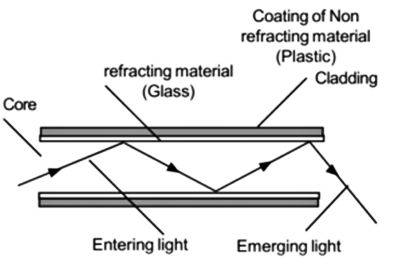
C. Write a comprehensive note on ‘Balanced Diet’
Question Breakdown:
In this question, the examiner has asked you to write a comprehensive note on Balance Diet. So write step-wise by initiating with the introduction what is Balance Diet. Then, write a very comprehensive explanation of all the components of a Balance Diet. Last, you can also add the importance of a Balanced diet in bullet form to comprehend your question. Keep in mind not to write too much in your GSA paper since the question contains no more than five marks. Hence, your question must be concise and complete at the same time.
Answer:
Balanced Diet:
A daily intake of food by humans is called a diet. The essential nutrients that are very necessary to our body are proteins, carbohydrates, vitamins, minerals, lipids, and dietary fibers. These nutrients are very important to maintain the health of the human body. If these nutrients are taken in a proper and adequate amount, the diet is called a balanced diet.
Components of a Balanced Diet:
The main components of a balanced diet are given below.
1. Vitamins:
Vitamins are the organic compounds that are essential for the proper growth of the body. They are required in very small amounts. In addition to it, they increase the absorption of essential nutrients into the body and play role in the production of blood cells and Deoxyribonucleic acid (DNA).
2. Proteins:
Proteins are of prime importance in a balanced diet. They play a crucial role in making protoplasm in cells and are also responsible for the production of enzymes, hormones, and antibodies. Furthermore, proteins are very essential for pregnant women to maintain the growth of their children.
3. Lipids:
The major constituents of lipids are fatty acids, glycerol, and sterol. Lipids are insoluble in water and soluble in organic compounds. They are a very good source of energy and are very essential for the formation of brain cells, and cell membranes. Moreover, lipids produce steroids.
4. Carbohydrates:
Carbohydrates are the most abundant biomolecule on the surface of the earth. They are the primary source of energy. Glucose is added into the bloodstream. From here, it provides energy to the body. The major resources of carbohydrates are cereals, grains, vegetables, and dairy products.
5. Minerals:
Minerals are essential to our body. These are not prepared by our bodies. Hence, there is a need for the daily intake of minerals to maintain the proper growth of the body.
Importance of a balanced diet:
The following are the importance of a balanced diet:
✔ A well-balanced diet also ensures protects the body against different non-communicable diseases, such as heart diseases, stroke, cancer, and diabetes.
✔ It helps in the proper growth of the body.
✔ It increases the capacity to work.
✔ A well-balanced diet also helps reduce weight.
✔ A balanced diet increases the ability to fight or resist diseases.
✔ The deficiency of diet can cause many disorders; for example, the deficiency of vitamins can cause scurvy, Rickets, etc.
✔ Likewise, the excess of some nutrients does more damage to the body than good; for example, excessive lipids can lead to various storage diseases like Gaucher disease, Sphingo-myelinase deficiency, Niemann-Pick disease (NPD), etc.
D. What is ‘Artificial Intelligence? How is it helpful for humanity?
Question Breakdown:
In the first part of the question, the examiner has simply asked you what Artificial Intelligence is in your own words based on your understanding. Start your answer with the definition of Artificial Intelligence with its discovery, example, and fields/ types. In the second part explain how it is helpful for humanity with proper headings and explain each use in two to three lines. Remember, writing too much can never assure you the maximum marks; the presentation of your paper is what matters.
Answer:
Definition:
It is the study of intelligent machines capable of performing the same kinds of functions that characterize human thoughts.
Discovery:
The term Artificial Intelligence was coined by John McCarthy in 1956 at the Dartmouth conference, Massachusetts Institute of Technology (MIT).
Example:
WABOT-2, a robot developed by Wasefa University in Japan in the 1980s, utilized AI programs to play keyboard instruments, read sheet music, and converse rudimentarily with people.
Two subsets under the term AI:
✔ Machine Learning
✔ Deep Learning
Uses of AI:
Financial institutions, scientists, psychologists, medical practitioners, design engineers, planning authorities, and security services use AI in their processes.
Advantages of AI:
✔ In playing games:
AI shows its intelligence in games such as chess and poker etc… In these games, AI can suggest the probability of taking the next winning step.
✔ Natural Language Processing:
Programming natural language in computers enables computers to understand any human language. It is only possible by AI.
✔ Expert Systems:
There is some software that is introduced for security purposes. For example, this software only recognizes the correct user and opens the password for face recognition, fingerprint recognition, etc. It is highly appreciable. Moreover, medical apps have been introduced where doctors’ services can be obtained by sitting at home.
✔ Recognition through speech:
AI has also played its role in recognition of voice. Only that person can unlock his mobile, door, and other devices that have set this setting.
✔ Robotic technology:
Robots have been made for the services of humanity. They can perform the same functions as humans can do. Therefore, robots have reduced the intensity of work for humans
✔ Google:
Google is also an example of AI. People can search for anything on the search engine just by typing. Google also displays the suggestions on the bar so people can easily search for their desired data.
Writing meaningful sentences, lines, paragraphs, and blogging helps children maintain positivity, sharpen their intellect, and think purposefully. Let’s get your kid(s) registered & turn him a youngest blogger!
Kids Online Writing Course

Question – 06
A. It takes 3 litres of paint to cover an area of 24 square meters. What percentage increase in the quantity of paint would be required to cover an area of 50.4 square meters?
Solution:
This question has come from the portion which is related both to the percentage as well as ratio and proportion. In order to find the percentage increase, first, we need to find the total amount of paint that will be used to cover an area of 50.4 square meters. Therefore, by using the ratio proportion method, we can write:
3 liter : x liter :: 24 m² : 50.4 m²
3 / x = 24 m²/ 50.4 m²
3 x 50.4 m² = x x 24 m²
151.2 / 24 = x
6.3 = x
Hence, 6.3 litres of paint are required to cover an area of 50.4 sq metres but the question doesn’t end here. Now, we need to find what percentage increase in 3 is 6.3.
So,
X % of 3 = 6.3 – 3
X / 100 x 3 = 3.3
3x = 330
X = 330 / 3
X = 110
Hence, the percentage increase will be 110 %.
B. An automobile travels 3 km towards the south, 4 km towards the west, 5 km towards the north and 2 km towards the south-east. How far is it from its starting position?
Solution:
This question has come from your geometry section and here the examiner has asked you to identify the distance an automobile had travelled. Now, in the question, you will first find out the triangle by using the Pythagoras theorem. When done, we will find out the distance he travelled by using the triangle and the formula applied.

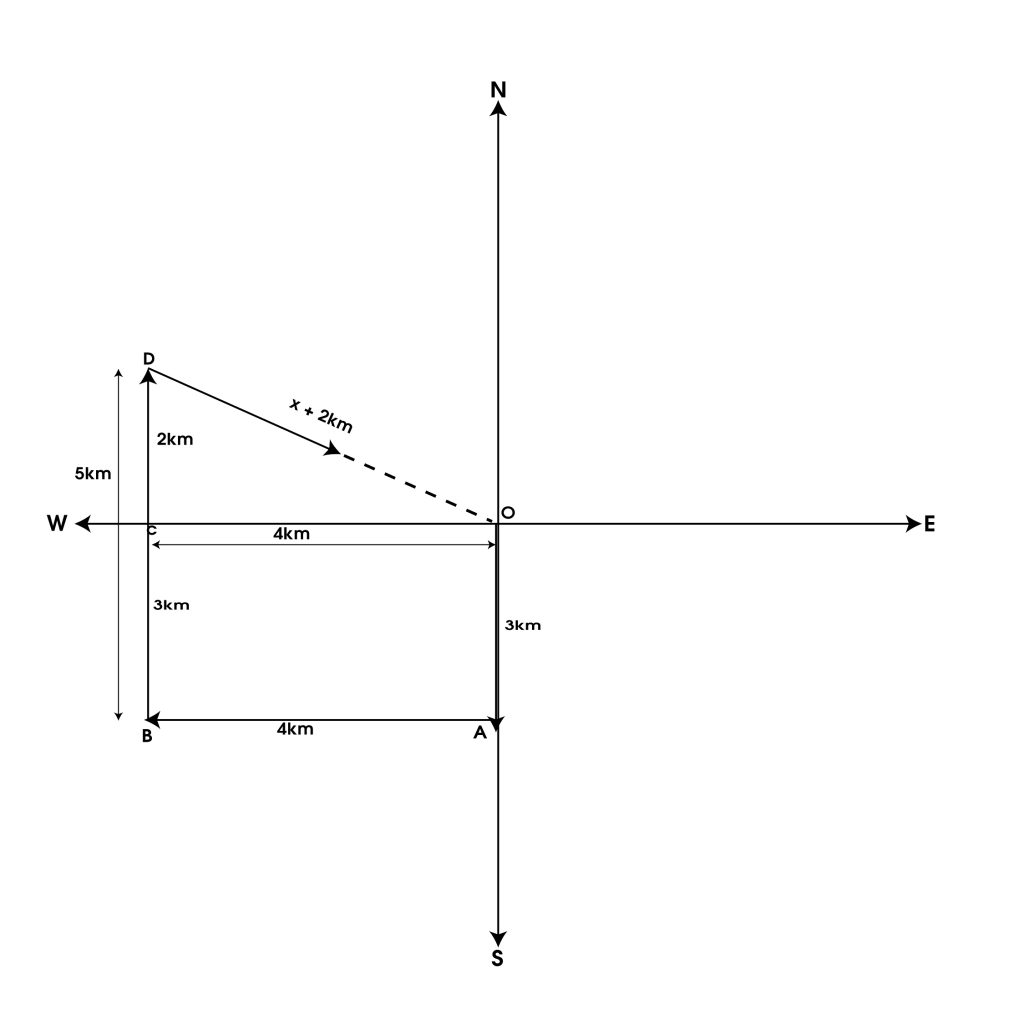
According to the Pythagoras theorem:

Taking square root on both sides:

C. Tahir started a business with a capital of Rs. 15,000. After 5 months Umar also joined him with an investment of Rs. 30,000. At the start of the 9th month, Usman joined them by investing Rs. 45,000. At the end of the year, they earned a profit of Rs. 406,000. Find the share of each one.
Solution:
This question is from your Ratio proportion section. In this question, the examiner has asked you to find out the share for each of the mentioned persons. Therefore, you need to simply apply the formula for the ratio of each of them. When done solve it accordingly.
Tahir’s Total investment in 1 year = 15000 x 12
= 180,000Rs Umar’s total investment in 1 year= 30000 x 7
= 210,000Rs
Usman’s total investment in 1 year = 45,000 x 4
= 180,000 Rs
So, we can say that the profit earned at the end will be shared in the ratio:
180,000 : 210,000 : 180,000
18 : 21: 18
6 : 7 : 6
Total share = 6 + 7 + 6
= 19
Now, we know from the statement of the question that:
Profile earned in a year= 406,000
So, Share of a person = profit earned/ total share x share of that person
Share of Tahir= 406,000/19 x 6 = 128,210.5 Rs
Share of Umar= 406,000/19 x 7 = 149, 579 Rs
Share of Usman= 406,000/19 x 6 = 128,210.5 Rs
D. A man left his property of Rs. 640,000. A debt of Rs. 40,000 was due to him and Rs. 5,000 was spent on his burial. Distribute the amount between his widow, one daughter and two sons according to Islamic Law.
Solution:
In this question, you simply have to find the net amount first. When done, calculate the share for each of the family members including the widow, the sons, and the daughter separately in accordance with the Islamic law.
Total property left by man = 640000
Debt amount = 40000
Amount spent on his burial = 5000
Now we can calculate the Net Amount as:
640000 – 40000 – 5000 = 595000 Rs.
Now, according to Islamic law, the widow’s share is 1/8, therefore:
595000 x 1/8 = 74375 rupees
Remaining amount =595000 – 74375
= 520625
Now, we know that as per Islamic law, the daughter’s share is equal to half of the son’s share. So, we can write in ratio as:
Son : Son : Daughter
2 : 2 : 1
Sum of their ratio = 5
Hence, each son’s share:
520625 x 2/5 = 208250 Rs
Daughter’s share:
520625 x 1/5 = 104125 Rs
For Verification:
Widow’s share + share of sons + share of the daughter= total amount left
74375 + (208250 + 208250 )+ 104125 = 595000
Question – 07
The breakdown of average monthly expenditure for a family is given in the following Figure:
A. Calculate from the figure what percentage of the family’s expenditure is on ‘other ’?
The total percentage is 100%
100% = 10% + 15% + 26% + 10 percent + 8% + 15%
= 84%
100%-84% = 16%
Hence, 16% is the percentage of expenditure on others.
B. Approximately what fraction of the family’s monthly expenditure do’ ‘utilities’, ‘rent’ and ‘food’ represent?
On utilization = 8% = 8/100
On rent = 26% =26/100
On food = 15% =15/100
Total expenditure = 8/100 + 26/100 + 15/100
= 49/100
= 49 percent
Approximately half of the expenditure is on utilities, rent, and food.
C. If the family spends Rs.11600 on utilities, how much is the family’s total expenditure?
On utilities, 11600 Rs are spent.
Hence,
A * percentage/100 = B
A * 8/1100 = 11600
A = 11600 * 100/8
A = 1,45,000 Rs.
D. ‘Other’ expenditure comprises savings, entertainment and luxury items, which are spent in the ratio of 3 : 4 : 1. Calculate how much the family saves each month if monthly income is Rs.24,000.
According to the given statement:
Monthly income = 24000
Now we know that the percentage spent on “others” is 16%. So,
16 % of 24000 = 16/100 x 24000
= 3840
Now, we know that the ratio is given as:
Savings: Entertainment: Luxury Items
3 : 4 : 1
Sum of all the ratios= 3+4+1 = 8
How much the family saves = savings ratio/total ratio x 3840
= 3/8 x 3840
= 1440 Rs.
Question – 08
A. Police officers are in pursuit of a stolen vehicle. Officer Baker is directly behind the stolen car. Officer Lopez is behind Baker; Officer O’Malley is behind Lopez. Officer Reinhart is ahead of the stolen car and coming from the opposite direction. Officer Reinhart makes a U-turn and joins the pursuit. He pulls in behind Officer Lopez. Officer Baker pulls up on the driver’s side of the stolen vehicle and Officer Lopez pulls up on the other side. Which officer is directly behind the vehicle?
Solution:
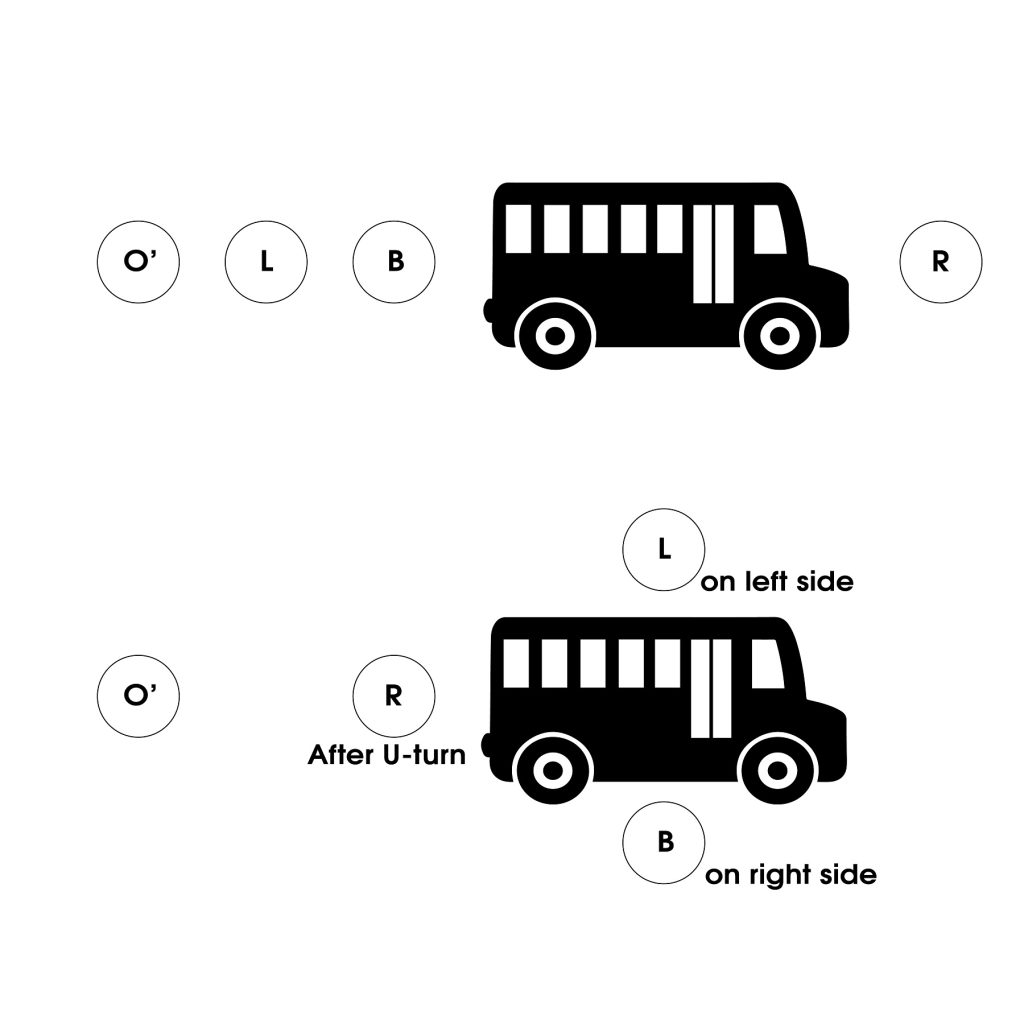
As the first diagram shows officer Baker, Lopez, Reihhart, and O’Malley are chasing the stolen vehicle.
According to the question, officer Baker pulls up on the right side of the driver and Officer Lopez on the other side i.e., the left side. Meanwhile, Officer Reihhart takes a U-turn and was pulled in behind at the initial place of officer Lopez.
So, as the second diagram shows, officer Reihhart comes directly behind the vehicle.
B. information may be deduced from it?
Solution:
Histogram:
It is the kind of graph in which the graph is drawn between the class boundaries on the x-axis and frequency on the y-axis.
Construction:
In the histogram, rectangles are formed that are adjacent to each other. The peak of the rectangle is directly proportional to the frequency. The higher the frequency is to higher the peak. In the data set, classes and frequencies are collected. The classes were then converted into class boundaries. Then these class boundaries are drawn on the graph to give a graphical representation.
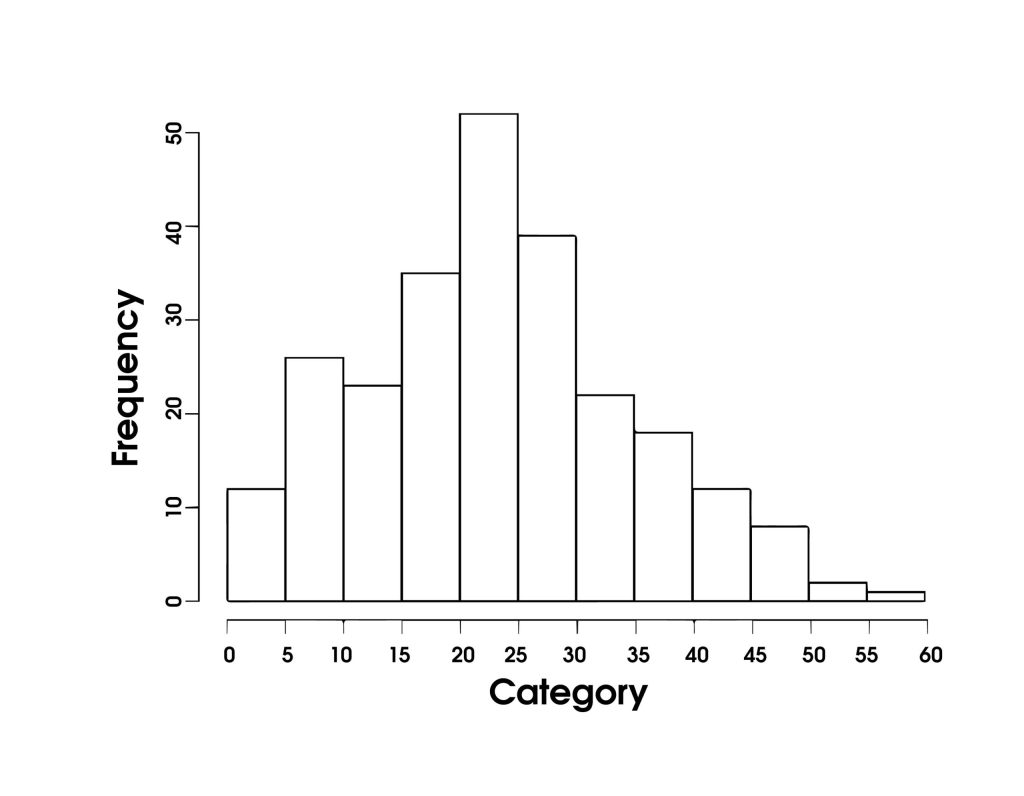
Information from the histogram:
The histogram is used to summarize the continuous data. It provides the visual interpretation of data, showing within a specific range. It also tells the point of maximum frequency. The median and distribution of data can easily be deduced by the histogram.
C. Look at this series: F2, __, D8, C16, B32, What number should fill the blank?
Solution:
This question has come from the logical reasoning part of the systematic series and we can observe that:
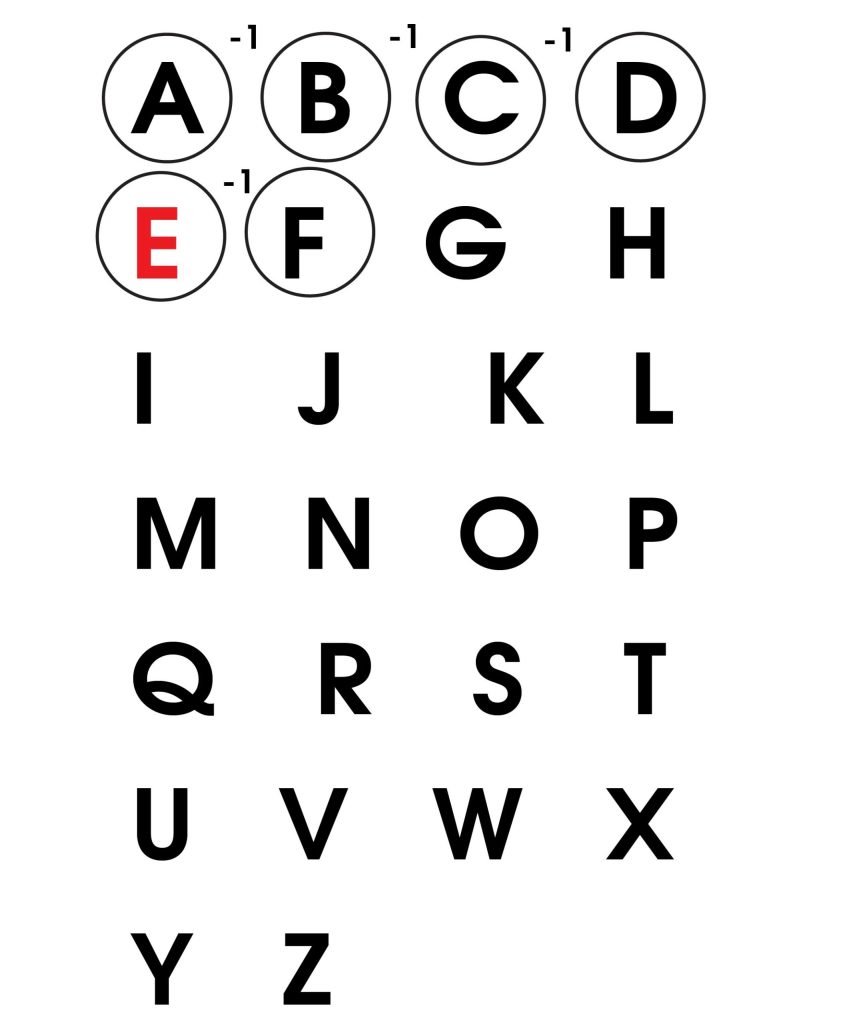
In this given pattern, the letters are decreased by 1; the numbers are multiplied by 2. Thus, the missing number in this series will be E4.

Thus, E4 is the missing number here.
D. In a certain code language LANDMINE is written as PYRBQGRC. How will HOMEMADE be written in that code language??
Solution:
This question has come from your logical reasoning part of coding-decoding. When solved that way we get the following pattern:

so we will do the same with the question in the statement which is being asked
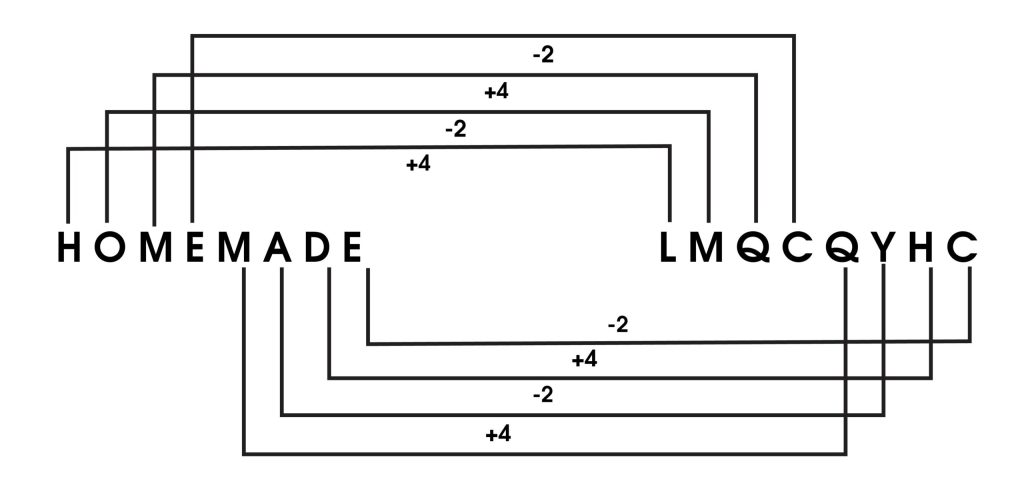
Thus, in that code language HOMEMADE will be written as LMQCQYHC
CSS Solved Past Papers’ Essays
Looking for the last ten years of CSS and PMS Solved Essays and want to know how Sir Kazim’s students write and score the highest marks in the essays’ papers? Then, click on the CSS Solved Essays to start reading them.
CSS Solved Essays

CSS Solved General Science & Ability Past Papers
| 1- | CSS Solved General Science And Ability Past Paper 2023 |
| 2- | CSS Solved General Science And Ability Past Paper 2022 |
| 3- | CSS Solved General Science And Ability Past Paper 2021 |
| 4- | CSS Solved General Science And Ability Past Paper 2020 |
| 5- | CSS Solved General Science And Ability Past Paper 2019 |
| 6- | CSS Solved General Science And Ability Past Paper 2018 |
| 7- | CSS Solved General Science And Ability Past Paper 2017 |
| 8- | CSS Solved General Science And Ability Past Paper 2016 |
| 9- | CSS Solved General Science And Ability Past Paper 2015 |
| 10- | CSS Solved General Science And Ability Past Paper 2014 |
| 11- | CSS Solved General Science And Ability Past Paper 2013 |
| 12- | CSS Solved General Science And Ability Past Paper 2012 |
| 13- | CSS Solved General Science And Ability Past Paper 2011 |
| 14- | CSS Solved General Science And Ability Past Paper 2010 |
| 15- | CSS Solved General Science And Ability Past Paper 2009 |
| 16 | CSS Solved General Science And Ability Past Paper 2008 |
| 17- | CSS Solved General Science And Ability Past Paper 2007 |
| 18- | CSS Solved General Science And Ability Past Paper 2006 |
| 19- | CSS Solved General Science And Ability Past Paper 2005 |
| 20- | CSS Solved General Science And Ability Past Paper 2004 |
| 21- | CSS Solved General Science And Ability Past Paper 2003 |
| 22- | CSS Solved General Science And Ability Past Paper 2002 |
| 23- | CSS Solved General Science And Ability Past Paper 2001 |
| 24- | CSS Solved General Science And Ability Past Paper 2000 |
Articles Might Interest You!
The following are some of the most important articles for CSS and PMS aspirants. Click on any to start reading.












